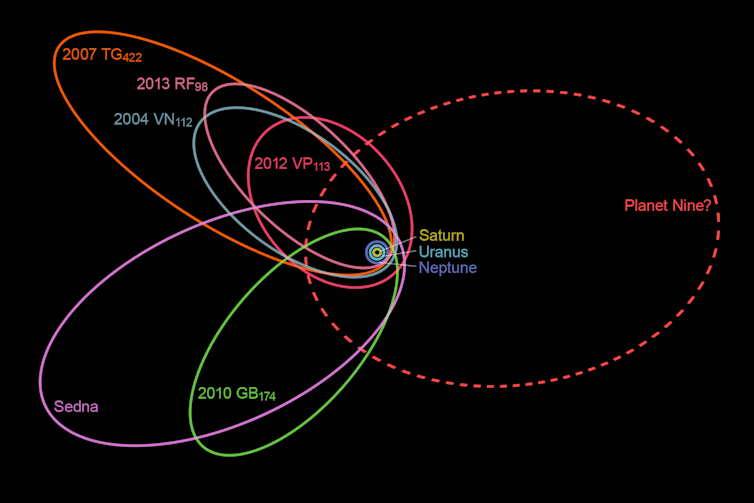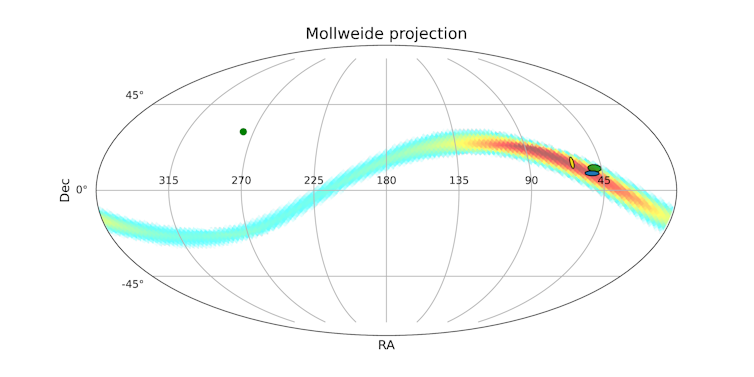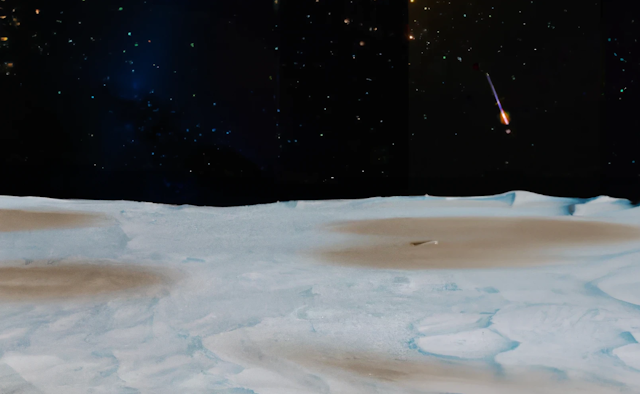We all used to think there were nine planets. But in 2006 the solar system was left with only eight planets, when Pluto was no longer classified as such. Is it still possible there is a planet out there beyond Neptune – possibly way beyond it?
In the last 20 years, we have made significant strides in exploring the outer solar system.
We are talking about what is known as Trans-Neptunian Space, the eternal night beyond the realm of the giant planets. And in this exploration we have come across a surprising population of inhabitants, the so-called Extreme Trans-Neptunian Objects, whose peculiar characteristics have given rise to intense debate in the scientific community.
Some researchers see in this population the manifestation of an invisible presence, a new planet not yet discovered in the dark and cold confines of our solar system. Others, however, think that there is no such planet and that these Extreme Trans-Neptunian peculiarities are due to the incompleteness of our limited observations, so-called “observational biases”.
A hypothetical huge and distant world
This hypothetical planet is provisionally known as Planet 9. Planet 9 is thought to not be a small object like Pluto or like many other Trans-Neptunian Objects that have been discovered in recent years. Detailed simulations have been created to theorise about the characteristics that the body might have in order to produce the effects observed, and the conclusion is that it must be a very large planet, consisting of between 4 and 8 times the mass of the Earth.
It must also be extremely far from the Sun: something like ten times the distance to Pluto. Probably even more.

If it exists, it would be a new type of planet, different from the others we know of at present in the solar system. Our planetary neighbours are basically classified into two types. They are either small, rocky worlds with a solid surface (Mercury, Venus, Earth, and Mars) or they are gas giants (Jupiter, Saturn, Uranus, and Neptune).
Planet 9 would fall somewhere in between these categories. It could be what is known as a Super-Earth, a rocky planet larger than our own, or a Sub-Neptune, a gaseous world less massive and slightly smaller than Neptune.
We have located planets like this around other stars but, being so far away, we know very little about them. Discovering one in our own solar system would open the door to studying in detail a category of planets that is almost unknown today.
The long journey of asteroid CNEOS14
How could we detect this Planet 9? It is not easy. Being so far away, its brightness would be extremely dim and we would need powerful telescopes. The problem is that these telescopes usually have a very small field of view. It is like using a microscope to scan a very large area for something small that we have dropped. In recent years, significant observational efforts have been made to try to discover this elusive world – so far without success.
A few months ago, a scientific article by two Harvard researchers was published stating that a meteorite (CNEOS14) that fell into the Pacific in 2014 was not an object from our solar system. This would be the first interstellar object that we have detected, a small asteroid approximately one metre in diameter that impacted our planet while travelling through the solar system at 60 kilometres per second.
This high speed is precisely what led researchers to determine its provenance as a visitor from other stars. To do that, they first had to rule out that the object had been accelerated or deflected by the gravity of a planet in our solar system, which is easy to verify by reconstructing its trajectory and seeing if it had passed close to any of the known planets or not – in this case, the asteroid had not passed near any known planets.
But, what if CNEOS14 had interacted with a planet not yet known during its journey through the solar system? This was the question that we asked ourselves and that opened up a new line of work.
An amazing coincidence
The first clue that there might be a connection between the CNEOS14 meteorite and Planet 9 appeared when we plotted on a sky map the orbit that the planet would have to have, according to the most detailed simulations, and then superimposed the origin of CNEOS14. We found a striking coincidence (see figure below) between the origin of the meteorite and the region where simulations predict that Planet 9 is most likely to be found. The probability that such a coincidence is the result of chance is of the order of 1%.

Following this line of thought, we did simulations reconstructing the trajectory of CNEOS14 and found three other statistical anomalies that would be highly improbable in an object that came directly from the interstellar medium.
Combining the probability of these irregularities, we find that either there is something we don’t understand about objects in the interstellar medium or there is a 99.9% chance that CNEOS14 ran into an unknown planet in the outer solar system – and that new world would be located right in the region predicted by the simulations.
These coincidences and statistical anomalies have led us to formulate the “messenger hypothesis”, referring to the use of the term “messenger” in astrophysics to denote particles that bring us information from celestial bodies. According to this hypothesis, CNEOS14 was perhaps deflected in our direction by an unknown massive object in the outer solar system, possibly Planet 9, between 30 and 60 years ago.
If the conjecture is correct, by tracing the trajectory of CNEOS14 backward in time, we would find the location of Planet 9 which, according to our calculations, would be very close to the point where the constellations Aries, Taurus, and Cetus meet.
We have an observation campaign underway at the Javalambre Observatory (Teruel) to carry out this search. The task is still difficult and it will take time and work, because the field to be scanned is still large and the object sought is very dim, but it does now seem doable.
Of course, today our hypothesis is no more than speculation, just like the existence of Planet 9 itself. However, it is a well-founded speculation that meets the three requirements to be taken seriously in science: a) it is physically plausible; b) it is well motivated; and c) it is empirically verifiable.
CNEOS14 could be indicating the position of Planet 9 to us. Or maybe it’s just a great cosmic coincidence. In any case, it is a beautiful story to which we could apply the old Italian saying that se non è vero è ben trovato (even if it is not true, it is well conceived) – an expression that, by the way, is attributed to an astronomer, Renaissance Friar Giordano Bruno.


